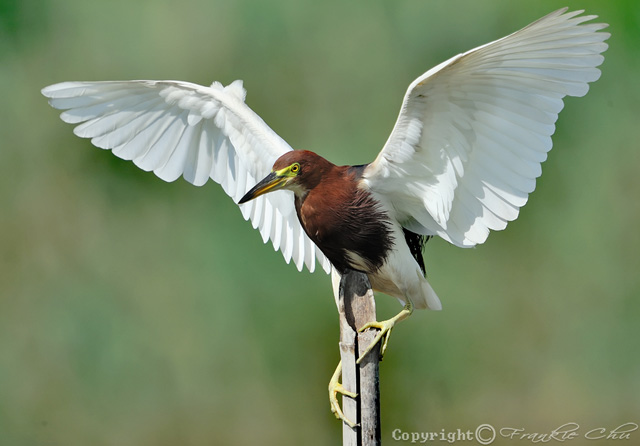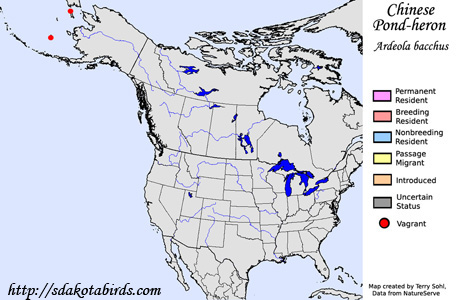| Length: 18 inches | Wingspan: 30-34 inches | Seasonality: Non-resident in South Dakota |
| ID Keys: White wings, long yellow and black bill, breeding male has reddish head, neck and breast with dark mantle feathers. Brownish mottled plumage in non-breeding plumage | ||
 The
Chinese Pond-Heron is a small heron species of southeast Asia. Several
small, closely-related "Pond-Heron" species are found in southern Asia.
In North America, the Chinese Pond-Heron is an extremely rare vagrant, with
just a handful of confirmed sightings in the
islands of the Bering Sea, off the west coast of Alaska.
The
Chinese Pond-Heron is a small heron species of southeast Asia. Several
small, closely-related "Pond-Heron" species are found in southern Asia.
In North America, the Chinese Pond-Heron is an extremely rare vagrant, with
just a handful of confirmed sightings in the
islands of the Bering Sea, off the west coast of Alaska.
Habitat: Found in both freshwater and saltwater habitats, including freshwater marshes and wetlands, estuaries, mangrove swamps. They have adapted very well to a human presence, and flooded rice fields are now a primary habitat for the species.
Diet: Feeds on a variety of aquatic creatures, including fish, amphibians, small reptiles, large insects, marine worms, crustaceans, and mollusks.
Behavior: Forages by walking slowly along the shoreline or in the shallows, thrusting its bill out to capture prey when prey is close. They also may wait motionless awaiting prey to approach. They may feed at any time during the day or night, but are most active near sunrise and sunset.
Nesting: The nest is a shallow platform of twigs and sticks, lined with softer vegetative material such as leaves and grasses. The nest is placed in a tree or in thick grassland or wetland vegetation near the water's edge. The female lays 4 or 5 eggs. Both parents help to incubate the eggs, and raise the young after the eggs hatch.
Song: Has a harsh croaking call, but they are usually silent.
Migration: Breeds from eastern India eastward through China. Migratory, with birds found throughout parts of southeast Asia in the winter. Some populations may be non-migratory, including those in eastern India.
Interactive eBird Map: Click for access to an interactive eBird map of Chinese Pond Heron sightings
Similar Species: Of other heron species in North America, most likely to be confused with the Green Heron.
Conservation Status: Populations are thought to be stable, and they are found over a relatively wide geographic area. The IUCN lists the Chinese Pond-Heron as a species of "Least Concern".
Further Information: 1) HeronConservation.org - Chinese Pond-Heron
2) OiseauxBirds.org - Chinese Pond-Heron
3) BirdLife International - Chinese Pond-Heron
Photo Information: Photo taken by Frankie Chu - Licensed Under Creative Commons Attribution NoDerivs 2.0 Generic License
| Click below for a higher-resolution map |
 |
| South Dakota Status: Non-resident in South Dakota |
Additional Chinese Pond-Heron Photos (coming soon!!)
